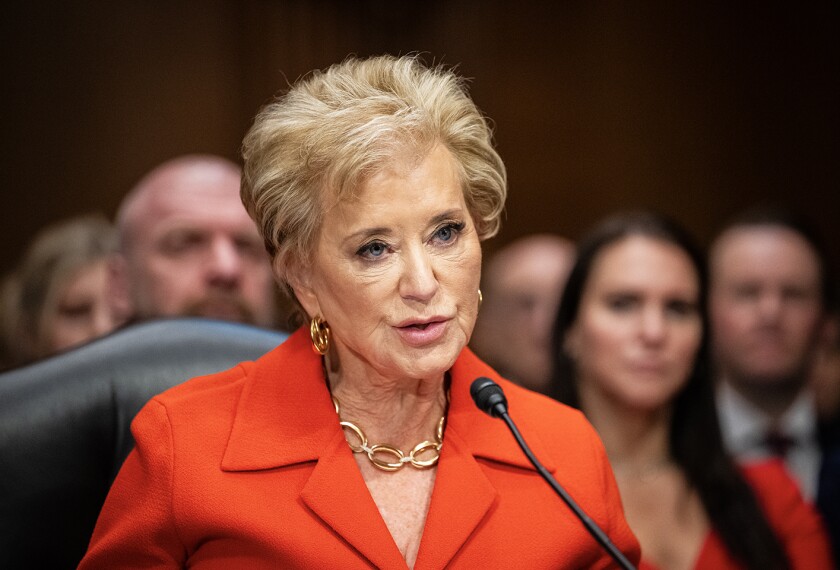Despite the attention focused on poor and minority students by the federal No Child Left Behind Act, most states are doing a poor job of narrowing achievement gaps, concludes a “report card” released last week.
Issued by the Washington-based Thomas B. Fordham Foundation, a conservative-leaning think tank, the report gives states an average grade of D on student achievement. It argues that progress has been negligible since the 1983 release of A Nation at Risk, the landmark report warning of a “rising tide of mediocrity” in American public schools.
“The Fordham Report 2006: How Well Are States Educating Our Neediest Children?” is available from the Thomas B. Fordham Foundation.
“Student achievement in the U.S. remains essentially flat even as the demands of a 21st-century economy stiffen and the education systems of other lands outpace ours,” the report says. “The U.S. urgently needs to become a nation in which every child learns to his or her full potential between kindergarten and 12th grade.”
Like Education Week’s annual Quality Counts report, Fordham’s report—which the authors describe as “unabashedly judgmental”—gives states letter grades, but it uses different indicators.
Each state received a student-achievement grade, based primarily on results from the 2005 National Assessment of Educational Progress in reading, mathematics, and science for African-American students, Hispanic students, and those from low-income families. Children from those groups on average trail on standardized tests compared with their white and Asian peers.
A quarter of the grade was also calculated using high school graduation rates for African-Americans, Hispanics, and children from low-income families, as well as statewide passing rates on Advanced Placement tests for students from those groups.
Of the 50 states, most made D’s, three made F’s, and six had insufficient data for the foundation to calculate a grade.
A new “report card” finds states have made too little progress in raising achievement by African-American, Hispanic, and low-income students.
*Click image to see the full chart.

SOURCE: Thomas B. Fordham Foundation
The report was originally released Oct. 25, but was withdrawn from the group’s Web site after errors in data were discovered. Still, the recalculations led to only minor changes.
In a press release, foundation President Chester E. Finn Jr. said the results dispute some of the rhetoric from state leaders about improving student performance.
“Many state officials have claimed credit for gains in student achievement,” he said. “But this study casts doubt on many such claims. In reality, no state has made the kind of progress that’s required to close America’s vexing achievement gaps and help all children prepare for life in the 21st century. Nor are most states making the bold reforms most likely to change this reality.”
Gloria Dopf, the Nevada education department’s deputy superintendent of instruction, research, and evaluative services, said she understands that researchers don’t have much choice but to use NAEP when comparing states. But the report ignores improvements in student performance on Nevada’s tests, which are aligned with NAEP, she argued.
“We do have performance gaps, but we are systemically working on those gaps, unlike the Fordham article indicated,” she said. “[The report] was very harsh, and not really reflecting some of the strategies and reform initiatives in the state.”
‘No-Nonsense Reforms’
States also received an “education reform” grade, which focuses on state efforts in the areas of curriculum content, standards-based reform, and school choice. In those areas, states don’t look so bad. The average score is C-minus, and three states—Arizona, California, and New Mexico—even received a B-minus.
To some extent, the states scoring near the top in the education reform category—California, Georgia, Massachusetts, and New York, for example—are among the same ones that ranked near the top in the foundation’s “State of State Standards” report, issued in August.
In the profile on California, the state scores points from Fordham for leading the nation in the number of charter schools in operation, hiring alternatively certified teachers, and eliminating bilingual education.
“If the no-nonsense reforms currently in place retain their stature in the state’s education establishment, the state’s school system could, in a few years, become a source of pride instead of the punch line for a bad joke,” the report says.
Hilary McLean, a spokeswoman for the California education department, said state officials were pleased that Fordham recognized “our high standards,” but added that working on closing the achievement gaps will be a major focus of the department over the next year.
Vermont, which the report called the “cellar dweller,” was the only state to receive an F for education reform. The report cites the state’s opposition to charter schools and a high school exit exam.
“In this small state of less than 600,000 people, 97 percent of whom are white, the idea that schools must be ‘reformed’ does not go down well with folks,” the authors write.
The report, which the foundation plans to issue annually, concludes by saying that even though some people are looking to the federal government to improve achievement among poor and minority students, the responsibility rests ultimately with the states—“every one of which has constitutionally obligated itself to educate its citizens, every one of which has created a ‘system’ for carrying out that obligation, every one of which sets most of the ground rules by which that system operates, and almost every one of which provides the lion’s share of the funding for that system.”







